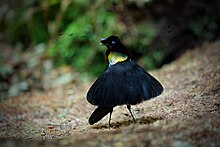The western or Arfak parotia (Parotia sefilata) is a medium-sized, approximately 33 cm long, bird-of-paradise with a medium-length tail.
| Western parotia | |
|---|---|

| |
| male | |

| |
| female | |
| Scientific classification | |
| Domain: | Eukaryota |
| Kingdom: | Animalia |
| Phylum: | Chordata |
| Class: | Aves |
| Order: | Passeriformes |
| Family: | Paradisaeidae |
| Genus: | Parotia |
| Species: | P. sefilata
|
| Binomial name | |
| Parotia sefilata (Pennant, 1781)
| |
Parotia comes from the Greek parotis, a lock or curl of hair by the ear, alluding to the head wires. The specific name sefilata is derived from the Latin word 'sex', meaning six, and filum, a thread or filament.[2]
Description
editLike other birds-of-paradise, the western parotia is sexually dimorphic. The male has jet black plumage, with striking iridescent scale-like golden-green breast shields and triangular silver feathers on its crown.[3] The occipital plumes (or head wires) arise from above and behind the eyes, with three long erectile wire-like plumes with smaller spatulate tips, above and behind each eye.[2] As with most members of the family, the female is unadorned and has brown plumage.[4] The species is similar to Lawes's parotia (Parotia lawesii).
Distribution
editThe western parotia is found only in the mountain forests of Vogelkop and the Wandammen Peninsula of Western New Guinea.[4]
Behaviour
editThe species is polygynous. Males presumably perform a series of courtship displays likely on terrestrial courts in exploded leks.[4]
In courtship display, the male performs a ballerina-like dance with its elongated black plumes spread skirt-like, right below the iridescent breast shield. During the spectacular dance, he shakes his head and neck rapidly to show the brilliance of his inverted silver triangle-shaped head adornment to attending females.
The nest is built and attended by the female alone; the breeding season is largely unknown.[2]
The diet consists mainly of fruits such as figs, and arthropods.[4]
Status
editA widespread and common species throughout its range, the western parotia is evaluated as Least Concern on the IUCN Red List of Threatened Species.[1] It is listed in Appendix II of CITES.
References
edit- ^ a b BirdLife International (2016). "Parotia sefilata". IUCN Red List of Threatened Species. 2016: e.T22706171A94054166. doi:10.2305/IUCN.UK.2016-3.RLTS.T22706171A94054166.en. Retrieved 11 November 2021.
- ^ a b c Gregory, Phil (2020). Birds of paradise and bowerbirds. London: Bloomsbury Publishing. ISBN 9781472975843.
- ^ Mobley, Jason A. (2008). Birds of the World. Marshall Cavendish. ISBN 978-0-7614-7775-4.
- ^ a b c d Hugill, Michael (2011). "Western Parotia". The Australian Museum.
